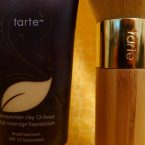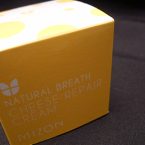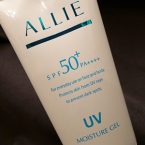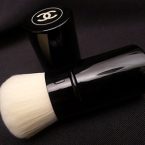Rohto Hada-Labo Gokujyun Super Hyaluronic Acid Lotion Review
Affiliate Links I Bought This July 1, 2014 | Asian Skincare, Moisturizer, Skincare, Toner
I just got home from a 4-day trip visiting relatives out-of-state, and as you might imagine, I’m not great at packing light when it comes to skincare (or makeup, for that matter). I do make an effort to scale down though, so when I packed for this trip, I opted not to bring along my Hada-Labo Gokujyun Super Hyaluronic Acid Lotion. Surely I could survive 4 days without it? Well, that was a mistake – I missed its righteous slippery, hydration every single day we were apart.
This hydrating toner was on my list to try for a very long time before I finally took a chance on it. I put it off for so long because the idea of a straightforward hyaluronic acid toner with no additional actives or plant extracts lacked the glamour I typically look for in my skincare products. Looking back, I realize that an unadulterated source of non-greasy, non-irritating, humectant moisture is exactly what my dry skin had been missing all along.
What is it?
Hada-Labo Gokujyun Super Hyaluronic Acid Lotion ($17) is a Japanese hydrating toner product. It promises instant, lasting, moisture with no irritation.
Ingredients:
Water, Butylene Glycol, Glycerin, Disodium Succinate, Hydrolyzed Hyaluronic Acid, Hydroxyethycellulose, Methylparaben, PPG-10 Methyl Glucose Ether, Sodium Acetylated Hyaluronate, Sodium Hyaluronate, Succinic Acid
The ingredient list for this formula is short and contains no SD alcohol, colorants, oil, or fragrance, making this a great product for sensitive skin types. The thing I love most about it, however, is the sheer dedication this ingredient shows to doing one thing, and doing it really well: moisturizing the living daylights out of my face with humectants.
Humectants are a class of moisturizers that differ from emollient and occlusive moisturizers. Emollients such as plant oils/essential fatty acids work by filling the spaces between skin cells, creating a smoother appearance and feel. Occlusive moisturizers such as petroleum and silicones work by creating a barrier over the skin, which prevents trans-epidermal water loss (TEWL). Humectants, however, work by pulling water into the stratum corneum from the lower layers of the skin, and in high humidity areas (70% and above), from the atmosphere. Humectants are generally able to hold far more than their own weight in water, which supplies significant hydration to skin and imparts a smooth, overall plumping effect.
For more information on the difference between classes of moisturizers, check out this summary:
Moisturizers: What They Are And How They Work
C. W. Lynde, MD, FRCPC
Toronto Hospital, Western Division, Assistant Professor, Department of Dermatology, University of Toronto, Toronto, Ontario, Canada
Here are the workhorse humectant ingredients for this formula:
Glycerin
Glycerin is an odorless, colorless, viscous sugar alcohol compound. Its humectant properties make it a popular cosmetic ingredient. Pure glycerin is able to absorb it’s own weight in water over a period of 3 days, and has been shown in numerous studies to improve skin elasticity, moisture, and barrier function.
Glycerol accelerates recovery of barrier function in vivo
Fluhr JW1, Gloor M, Lehmann L, Lazzerini S, Distante F, Berardesca E.
Acta Dermato Venereologica, November 1999
Glycerol replacement corrects defective skin hydration, elasticity, and barrier function in aquaporin-3-deficient mice
Mariko Hara, A. S. Verkman.
Proceedings of the National Academy of Sciences of the United States of America, May/June 2003
Hydrolyzed Hyaluronic Acid
Hyaluronic acid (also called hyaluronan) is a polysaccharide naturally produced in the human body. Able to hold 1000 times its weight in water, hyaluronan plays an important role in wound healing as well as maintaining the structure and integrity of our skin. Like many of our naturally occurring beneficial skin components, we produce less hyaluronic acid as we age. Thankfully, we can topically apply some forms of hyaluronic acid and still obtain its hydrating, smoothing, wound healing, and barrier strengthening effects.
Hada-Labo Gokujyun Super Hyaluronic Acid Lotion contains three different forms of hyaluronic acid: hydrolyzed hyaluronic acid, sodium acetylated hyaluronate, and sodium hyaluronate (which is actually a sodium salt derived from hyaluronan).
Standard hyaluronic acid molecules have a high molecular weight, meaning the molecules are large – too large, in fact, to effectively penetrate the skin when applied topically. Standard hyaluronic acid typically needs to be injected in order to be effective. To reap the benefits of topically applied hyaluronic acid, the molecules need to be smaller. The molecular weight of hydrolyzed hyaluronic acid is low, meaning the molecules are smaller and able to more deeply penetrate the skin.
The deeper penetration of this form of hyaluronic acid does come with a sacrifice – its small molecular size makes it less effective for holding water, so its effects are shorter lived. However, it still has fantastic temporary plumping benefits, and it works quickly to moisturize and smooth out fine lines.
Hydrolized Hyaluronic Data Sheet
Evonik Industries, 2008
Sodium Acetylated Hyaluronate
Sodium acetylated hyaluronate is a form of hyaluronic acid that is patented by Shiseido. Like hydrolyzed hyaluronic acid, it has a low molecular weight that allows it to penetrate the skin more deeply and quickly than a high molecular weight HA such as sodium hyaluronate. The quality that makes sodium acetylated hyaluronate unique is that it possesses both hydrophilic and hydrophobic properties, allowing it to more effectively hold in water than other low molecular weight HA such as hydrolyzed hyaluronic acid. The result is longer term hydration, skin-softening, and smoothing effects.
Patent information: Low molecular weight acetylhyaluronate, skin-softening composition, method of manufacturing the same, and method of purifying the same
Takashi Oka, Toshio Yanaki, Michihiro Yamaguchi.
Shiseido Co., Ltd., 1997
Sodium Hyaluronate
Sodium hyaluronate is the sodium salt of hyaluronic acid. It also has a low molecular weight, and is able to penetrate skin effectively and draw in and hold water. IT’s a powerful humectant, and its skin smoothing, hydrating, and softening properties make it an extremely popular cosmetic ingredient.
According to CosDNA, this formula contains no red flags for irritants or potential acne triggers.
Performance
Appearance
Hada-Labo Gokujyun Super Hyaluronic Acid Lotion comes packaged in a plastic bottle with a white label. The contents of the label are written almost entirely in Japanese. The dispenser for the product is a small opening underneath a flip-top cap.
The product itself is a clear, slippery, viscous liquid that is significantly thicker than water, but still far more liquid than a gel or cream.
pH
Hyaluronic acid performs best at a pH greater than 4.0 and less than 11.0. I prefer my skincare products to have a pH less than 7.0 (read more about why a lower pH is important here). Hada-Labo Gokujyun Super Hyaluronic Acid Lotion has an appealingly low pH of 5.0.
Smell
Hada-Labo Gokujyun Super Hyaluronic Acid Lotion doesn’t smell like much of anything.
Application
I apply Hada-Labo Gokujyun Super Hyaluronic Acid Lotion as my 4th step in my morning & evening skincare routine. Its place in my routine looks something like this:
Cleanse > Acid Toner > AHA, BHA, and/or Vitamin C Serum > [wait 10-25 minutes] > Hada-Labo Gokujyun Super Hyaluronic Acid Lotion
To apply, I squeeze out a small, coin-sized amount into my hands, then spread it over my face. I’ll often gently massage or press it into my skin to accelerate absorption. When the product is mostly absorbed and my skin slightly tacky, I continue with the rest of my skin routine (serum > face oil > moisturizer).
Although you don’t necessarily need to use all the products I use in my typical routine to benefit from this HA lotion, I do highly recommend sealing it in with an oil or an occlusive moisturizer at the very least. Hada-Labo Gokujyun Super Hyaluronic Acid Lotion has fantastic humectant properties, but it doesn’t contain any emollient or occlusive moisturizers, which you’ll need to prevent any of that spectacular hydration from escaping.
Results
The first time I used Hada-Labo Gokujyun Super Hyaluronic Acid Lotion, I could not stop touching my face. The last time my skin felt that hydrated and soft, I was in my early 20s. With continued use, here are some other benefits I experienced:
• No more flaking from AHA or BHA use
• No more flaking or peeling at the end of the day, which also meant my makeup lasted longer
• No waking up with dry skin
• Overall increased moisture
• Decrease in the slight fine lines around my eye area (though only minor changes in the one deeper line by my right eye)
• Less skin sensitivity
I did not experience any breakouts or irritation as a result of using this product. In fact, I find the Hada-Labo Gokujyun Super Hyaluronic Acid Lotion to be very soothing, especially after applying my acid treatments.
I don’t know how I lived without this product for so long. If you have dry skin, Hada-Labo Gokujyun Super Hyaluronic Acid Lotion is a bonafide game changer. If you have oily skin, you’ll appreciate its non-greasy moisturizing properties, and the fact that you can get away with using far less moisturizer than usual.
The next time I travel, there no way I’m leaving my Hada-Labo Gokujyun Super Hyaluronic Acid Lotion behind.
Pros & Cons
| Pros | Cons |
|---|---|
|
|
Skin & Tonics Rating
| A+ | 20/20 Efficacy | 20/20 Ingredients | 20/20 Application | 20/20 Wear | 20/20 Packaging |
|---|---|---|---|---|---|
| Total: 100 | Rating system details » | ||||
Where to Buy
| Store | Price | Offers | |
|---|---|---|---|
| Amazon.com | $16.88 | Available for Prime shipping. Ships from US. | buy |
| Traveler-com (eBay Seller) | $16.89 | Ships free from Japan. | buy |
| Drugstore.com | $19.99 | Orders over $35 ship free. | buy |
This post contains affiliate links. Shopping these links helps support this site. Full disclosure »




















I’m a big fan of HadaLabo products in general, but it’s easy to see why this is one of their most popular products. Now that I think about it, this might have been one of my first Asian skincare products ever. It was definitely the one that converted me.
By the way, the name is spelled gokujyun. It means “extra moisturizing” in Japanese. 🙂
Thanks, Audrey! Spelling updated! I was using the spelling from the Amazon listing – I actually noticed it spelled different ways from multiple sellers, and I wasn’t sure who had it right. 🙂
Hi Kerry! long time follower of your blog. i love reading your in-depth reviews. I was using the this toner until i found that it broke me out. then i was using klairs toner and that also broke me out. upon looking at the ingredient list, i’ve found that they botch contained butylene glycol. apparently my skin is sensitive to it and when doing more research, i’ve found that this is a comedogenic ingredient for a lot of people. i’ve bummed out because i loved the way my skin felt after putting on this toner.
You could try the Makeup Artists’ Choice Hyaluronic Serum. No butelyne glycol, but it is much more expensive. They do have a sample size, though!
Hadalabo makes a “light” version of the Gokujyun Lotion (I’m assuming for oily skin rypes), which doesn’t contain butylene glycol. The ingredients list is:
Water, dipropylene glycol, glycerin, disodium succinate, hydrolyzed hyaluronic acid, methylparaben, ppg-20, methyl glucose ether, sodium acetylated hyaluronate, sodium hyaluronate, succinct acid
Hi Kerry! I really enjoy reading your blog~ I look forward to your posts.
I got the hada labo moisturizing milk when I was in Japan and it’s a little heavy for my combo skin. It doesn’t help that it’s so hot and humid where I’m at -.-
I had a quick question. Would it be over kill to use a cleanser -> bha liquid (20-25 mins) -> Benton BHA toner -> Missha’s first treatment essence -> benton snail bee essence -> and a cream?
Hi Sharon! Just curious – did you try the milk or the lotion? I ask because they are very different products. The milk is more like a creamy lotion while the lotion is clear, viscous, serumy consistency.
I don’t think your routine sounds like overkill – I know quite a few people that swear by using both the Benton toner and the Missha FTE in the same routine. I’ve even done it myself on occasion. 🙂
I did try the milk. It was an opaque white but still a little runny. Not clear like the lotion in your photos. I think the milk will be perfect come winter time.
haha I was worried that it was a little too much, but I figured it would be okay because the first treatment essence is considered a booster. Did you notice any differences?
I used this for a while, and once it was done i figured I didn’t need it….but nope i, I MISS IT SO MUCH 🙁
It’s so good!
This sounds like a promising product. I reviewed a similar lotion from Hada Senka a couple of days ago, which contains hyaluronic acid aswell. I’d be curious how these two compare 🙂 (It may be that I wrote this comment twice, if so, feel free to remove one XD)
Do you remember the name of the Hada Senka one? I’d be interested in trying that!
Hi!Really good review!Honestly I’ve heard of many forms of Hyaluronic acid but I’wasn’t sure about the differences between theme.This product sounds tempting and it’s definitely affordable=)Have you heard of JUJU’s Aquamoist Hyaluronic Acid Essence, It’s true that it comes in a smaller size,but I’think the ammount of HA is greater,but I’m not sure. I’ve used it a year ago and I remember that it had exact opposite reaction on my skin,instead of moisturizing it dried out my skin ..so weird. Maybe it would have been better if I was mixing it with a moisturizer? Anyhow,I guess they had reformulated it :
Water, sodium hyaluronate, hydrolyzed sodium hyaluronate, hydroxypropyltrimonium hyaluronate, phenoxyethanol, sodium citrate, methylparaben, citric acid
(from makeupalley)
But once again,there is this new form ah HA, would you know more about hydroxypropyltrimonium hyaluronate? There are so man forms of HA,it can be really confusing sometimes..
Once again excellent post! 😀
Hi Aion! I don’t know much about that particular form of HA, but I’ll be reading up on it now. I’ve heard others say great things about the JUJu Aquamoist as well – it’s definitely going on my list. Thanks so much for the rec! 🙂
Hey Kerry! Great post, as usual! c: I’ve been using the light version of this lotion for a few weeks now and I love it!
I’ve got a question about your routine though: You said your routine follows this order –> “Cleanse > Acid Toner > AHA, BHA, and/or Vitamin C Serum > [wait 10-25 minutes] > Hada-Labo Gokujyun Super Hyaluronic Acid Lotion”
Shouldn’t you use the Hada-Labo Lotion after your acid toner and before the serum? As far as I know Japanese lotions are designed to prepare your skin for the following skin care stuff and should therefore be put on before serum, cream etc.
So, did I get something wrong? Or are there more ways to use this lotion? Or do you use the products in this order because of their pH? Please explain it to me ^^;
Hi Yuri! Great question! I use the products in this order because I like all my low pH/pH sensitive products to go on immediately after washing my face. If I wasn’t using anything that required a low pH (<4.0) to work, I would use the Hada Labo lotion immediately after cleansing. 🙂
I use Aquamoist which is pretty similar, I believe. It’s super hydrating and I often skip this in the day over summer as it can get heavy even though my skin is dry. However I love it at night, for lotion masks and for use on my body!
I definitely want to try the Aquamoist – it sounds like a very similar product! Where do you like to buy yours?
I had a small sample of this, I used it in winter and everything was extremely dry. The air, my face everything!
I wasn’t a fan of it, I was expecting miracles but I got almost no change in hydration. It is very possible that I needed to use something more hydrating on top to give it a boost. Or maybe it works better in the summertime?
Now reading your review I definitely want to try it again though!
If you used it on its own, it probably wouldn’t have worked so well since it doesn’t contain any emollients or occlusives. I think you should give it another chance this winter and top it off with moisturizer to lock in all that humectant goodness! 🙂
I actually did use it with a moisturizer! But nothing really impressive to be honest. I had huge problems with dry and dehydrated skin this winter. I don’t remember what moisturizer I used with this, it didnt work so I forgot.
But now that I have discovered more hydrating creams vs moisturizing, I have started mixing them and it works better for my skin now, even though I am still in search of an HG so I can only use one moisturizer on top of all the other items I use.
But I will definitely try it again!
Have you used the juju aquamoist one? How do they compare?
I haven’t used the JUJU Aquamoist yet, but it’s definitely on my list!
Hmmmm, I don’t have any skincare products with Hyaluronic acid. Guess this is another must-have to add to my next beauty haul! Have you done any face mist reviews yet? I’m discovering that this NYC heat is killing me and my skin is suffering. Chriselle Lim shared some she found in Korea, but I don’t know much about that brand. I know Sheryll reviewed a few but I’m still searching for one that will be perfect for me.
Hi Tiffany! I haven’t done any face mist reviews recently. I’ve been using the Innisfree Green Tea mist lately and have been enjoying it. Sheryll’s favorites are all on my list to try as well!
This stuff has meant *everything* to my skin while it’s been under attack by lupus. It has helped me immeasurably! I’m not even done with my 30 days yet and I’m already itching to write about it!
I can’t wait to read your review!
Hi Kerry!
I’ve heard so many good things about this brand, so I’ve tried the Hado Labo Replenishing Hydrator from Ulta (the US version) since its more accessible that way. However, I’ve gotten bumps on my face that I’ve never gotten before, so I stopped using it. I was curious to try the Japanese version since it looks like it has less ingredients and may work out better, but I’m a little scared to try. Should I go for it or no?
Hi Katie! Yes, the formulas for the US and Japanese versions are different. Here are the ingredients for the US version:
Water, Butylene Glycol, Glycerin, Citric Acid, Dipropylene Glycol, Hydrolyzed Hyaluronic Acid, Hydroxyethylcellulose, Iodopropynyl Butycarbamate, Methylisothiazolinone, PPG 10 Methyl Glucose Ether, Sodium Acetylated Hyaluronate, Sodium Chloride, Sodium Citrate, Sodium Hyaluronate
It’s possible that the ingredients that caused your irritation are only present in the US formula. Do you have any guesses as to what you might be sensitive to?
Hello Kerry! Great post! I’ve been itching to try one of their “lotions” for awhile now but because I’m oily I may go for the whitening one once I’m through with my vitamin c serum! Curious to hear your thoughts on the Hada Labo products offered at Ulta! Especially the cleanser and gel cream that totes an impressive function! It’s supposed to replace every step after cleansing and toning!! Would love to hear your thoughts! 🙂
Hey Anna! I’ve been curious about the Ulta Hado Labo products as well. I hope to try them out before the end of the year! 🙂
Ohh, exciting! I’ll try that soon! 😀 Thanks for the in-depth and well-researched review <3
Thanks so much for this review. I ordered immediately after reading it and the following comments. I have extremely dry skin so have high hopes for this. I’ll be sure to use along with an emollient/occlusive product.
[…] Als “Wegbereiter” für die eigentliche Creme habe ich eine Lotion (oder Emulsion), die Gokujyun Super Hyaluronic Acid Lotion von Rohto Hada Labo. Entdeckt durch diese Review. […]
Hi, Kerry!
I just read the production description for the lotion from the ebay seller and the ingredients list (written below) differs from the one you have posted. It ostensibly contains a few questionable ingredients so I would be ever so grateful if you could let me know if you’ve any idea as to why that is!
Thank you 🙂
Water, glycerin, caprylic acid/capric acid, glyceryl, DPG, squalane, An olefin oligomer, PPG-10 methyl glucose, hydrolysis hyaluronic acid (nano-ized hyaluronic acid), Acetyl hyaluronic acid Na (super hyaluronic acid), hyaluronic acid Na, isostearic acid PEG-20 Sorby Tan, glyceryl stearate, stearyl alcohol, TEA, EDTA-2Na,etc
Love love love your site, Kerry, thank you for your awesome reviews! I am curious if you’ve ever compared the Hada Labo Hyaluronic Acid Lotion to the MUAC Hyaluronic Acid Serum.
I know that ieatbugs (your neighbor, I believe?) on SCA prefers MUAC’s over Hada Labo’s…do you have a preference? If so, why?
Thanks again!
Thanks, dweamz! I haven’t tried the MUAC Hyaluronic Acid Serum yet. I’ll definitely check it out though – I’m on an intense hyaluronic acid kick these days!:)
Hi Kerry!
I went ahead and purchased this a few weeks ago after reading your review and I absolutely love it, thank you! 😀 I just had a question regarding the application process of my skincare products as I just received the OST Vitamin C Serum today and have been going back and forth reading different blogs of what step this should be applied in. I use the Hada Labo Gokujyn Hyaluronic Lotion as my toner but I see that it has a pH of 5.0 and I read in your morning skincare routine that the Vitamn C serum requires a pH of less than 3.5 to perform optimally :O Since this is the case, would it be bad to mix the two together? Or if applied separately, which one should I apply first and how long should the wait time be in between before I apply the other? (I plan to only use the serum at night so I have the patience to wait if need be) xD
Hi there! I absolutely LOVE your reviews! Especially the ones on Japanese and Korean brands, since I have asian skin but do not any products from Korea/Japan at all. I work with skincare brands such as Caudalie, Dermalogica, Avene, La Roche Posay, Nuxe- lot of French ones basically.
I have few questions: the Gokujyun Lotion (is it a toner, moisturiser? serum?) not sure if it would come right after washing your face or after a serum…
Also, more importantly, is it okay for combination skin? I know a lot of your reviews are based on results of your dry skin. Mine is very oily in the T-zone and dry on the rest of the face. Would the Gokuhyun Lotion and Rice Skin Softener (which once again, is a toner? serum?) be okay on my combination skin?
Thank you in advance for your time!
Hello ! Thank you for your post !
I really like your blog because you add the ingredients list and the Ph of the product ! Really great.
I was wondering why you don’t talk about parabens and other bad ingredients in this production ? Is it because it’s no big deal for you or if it’s because you don’t know about them ?
Maybe you would like to read this informations regarding the ingredients coposing this product : http://www.slow-cosmetique.org/#!infographie-cosmetiques-slow/c1z4g
I’m not complening or anything. It’s a genualy question.
Sorry for my nad englis, I’m not fluent in the language yet.
Hi Acide! Great question – and I think your English is just fine! 🙂
The reason I don’t talk about parabens is that the link between parabens and cancer has been debunked for quite some time. The original scare was based on a misinterpretation by marketers and media of a study conducted back in 2004 – and even that study did not find parabens to be cancer causing – it only found them present in trace amount in tumors, but nowhere was there indication that they were a factor in causing them. Since then, there have been numerous studies to explore whether or not there is a link between parabens and cancer, and they have all come to the same conclusion – there isn’t. Which is a big relief – if parabens were actually cancer causing, we’d all have to stop eating blueberries, strawberries, peaches, carrots, onions, cocoa-beans, vanilla, grapes, and fruit juices – all of these foods contain naturally occurring parabens! Plants synthesize methyl paraben because they’re preservatives and protect the plants from bacteria and fungi.
The paraben scare (and much of the fearmongering around other “unnatural chemicals”) is manufactured by cosmetic companies who are looking to make money by instilling fear in their consumer base. And while there are some great “natural” products out there, most of them are cheaper to produce and have a higher profit margin than properly preserved and scientifically formulated products, so there is a lot of incentive to keep people misinformed. In some cases, even the companies themselves are misinformed.
As for other “harmful” chemicals – I cover this a bit in my FAQ:
“Basically, the idea that products containing only non-synthesized, ‘natural’ ingredients are safer and/or better is flat out incorrect. There are good and bad ingredients, and being “from nature” is not a factor in safety or efficacy. There are harmful ‘natural’ ingredients, and there are beneficial ‘chemical’ ingredients. I’m using quotes there because everything is a chemical, no matter how natural it is, so using the word ‘chemical’ to describe an ingredient you don’t consider to be natural is inaccurate.
I use and review products based on efficacy, regardless of the ingredient source. Sometimes these products contain unsynthesized, easily pronounceable ingredients, and sometimes they contain things like ‘Methoxy PEG-114/Polyepsilon Caprolactone.’ If I uncover safety issues with an ingredient in a product I review, I will definitely cover it in my post.”
If you’d like to read up more on parabens, here are some reports from various institutions that go into more detail on the topic:
FDA: http://www.fda.gov/cosmetics/productsingredients/ucm128042.htm#Are_there_health_risks
European SCCP: http://ec.europa.eu/health/ph_risk/committees/04_sccp/docs/sccp_o_00d.pdf
National Cancer Institute: http://www.cancer.gov/cancertopics/causes-prevention/risk/myths/antiperspirants-fact-sheet
American Cancer Society: http://www.cancer.org/cancer/cancercauses/othercarcinogens/athome/antiperspirants-and-breast-cancer-risk
I hope that helps!
Hi!
I just bought this after reading your review can’t wait to try it! I was wondering in what order should I put this only face, before or after using an exfoliating toner like the Paula’s choice one? Thank you ♡
Hey! Just wanted to let you know I used your link and bought this today. I can’t wait to try it. I hope my dry skin thanks me. 🙂
[…] face, your skin will be as plump and moist as a baby’s bum — not kidding! Here is an in–depth review of this product by my favourite skincare blog, […]
so is this a toner or moisterizer im so confused pls help
Same. Halp.
Hyaluronic Acid (HA) has now superseded collagen as the go-to ingredient. I get my hyaluronic acid from the Made from Earth Plant Stem Cell Moisturizer – its uses botanical hyaluronic acid.
The main effect of this Made from Earth moisturizer is making my skin seem much fuller and plumped up. This doesn’t mean you will look fatter! The skin just looks much more healthy and glowing. It is a more youthful effect all round. It evens out the skin, so the tone is improved and the crow’s feet that were starting to take over are diminished gradually with use.
Just a little bit is needed for one application – I am impressed
If I were going to use this with CosRX Galaxtomyces 95 Whitening Power Essence would I use the CosRX first or this first?
Hi thank you for the detailed article, very informative! Do you know if this product is vegan ?